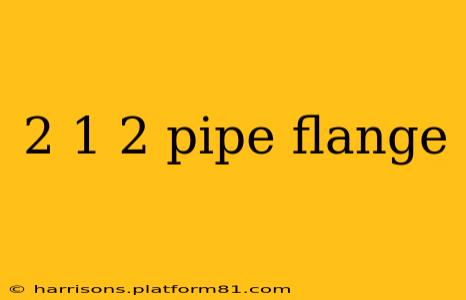Decoding the Mystery of the 2 1/2" Pipe Flange
The seemingly simple designation "2 1/2" pipe flange" actually encapsulates a world of specifications crucial for proper pipe system installation and safety. Understanding these specifications is key for engineers, plumbers, and anyone working with piping systems. This comprehensive guide delves into the details of this common component, answering frequently asked questions and providing valuable insights for professionals and DIY enthusiasts alike.
What does a 2 1/2" pipe flange mean?
The "2 1/2"" refers to the nominal pipe size (NPS). This isn't the exact inside diameter of the pipe, but a standardized designation used for pipe and fitting sizes. A 2 1/2" NPS flange is designed to connect to a pipe with a nominal diameter of 2 1/2 inches. The actual inside diameter will vary slightly depending on the pipe schedule (wall thickness). Understanding this distinction is vital to avoid compatibility issues.
What are the different types of 2 1/2" pipe flanges?
Several types of 2 1/2" pipe flanges exist, each designed for specific applications and pressure requirements. Common types include:
- Slip-on flanges: These flanges slip over the pipe end and are welded or bolted in place. They are relatively easy to install but offer slightly less strength than weld neck flanges.
- Weld neck flanges: These flanges are welded directly to the pipe, providing superior strength and resistance to high pressure and temperature. This makes them ideal for critical applications.
- Threaded flanges: These flanges are threaded onto the pipe, offering a simpler installation process compared to welding. However, they might not be suitable for high-pressure applications.
- Blind flanges: These are solid discs used to close off the end of a pipe. They are often used for maintenance or isolating sections of a pipeline.
- Lap joint flanges: These flanges feature a stub end which is lap welded to the pipe, offering a balance of strength and ease of installation.
The choice of flange type depends heavily on the application, including pressure, temperature, and the corrosive nature of the fluid being conveyed.
What is the pressure rating of a 2 1/2" pipe flange?
The pressure rating of a 2 1/2" pipe flange isn't solely determined by the size but also by its class, material, and design. Flange classes indicate their pressure and temperature capabilities. Common classes include 150, 300, 600, 900, 1500, and 2500. Higher classes indicate higher pressure ratings. Consult the relevant ASME B16.5 standard for specific pressure and temperature ratings for different flange classes and materials. Improperly selecting a flange based on pressure requirements can lead to catastrophic failures.
What material are 2 1/2" pipe flanges made of?
2 1/2" pipe flanges are made from a variety of materials, including:
- Carbon steel: A common choice for general-purpose applications.
- Stainless steel: Used where corrosion resistance is required.
- Ductile iron: Often selected for its strength and durability.
- Cast iron: Suitable for lower-pressure applications.
Material selection depends on the application’s specific needs, considering factors such as corrosion resistance, temperature tolerance, and strength requirements.
How do I choose the right 2 1/2" pipe flange for my application?
Selecting the correct 2 1/2" pipe flange involves carefully considering several factors:
- Nominal pipe size: Ensure it matches the pipe's NPS.
- Flange type: Select a type suitable for the application's pressure, temperature, and installation requirements.
- Flange class: Choose a class that meets or exceeds the system's pressure and temperature requirements.
- Material: Select a material that offers the necessary corrosion resistance and strength.
- Gasket type: The gasket material should be compatible with the fluid being conveyed and the flange material.
Always consult relevant standards and specifications (like ASME B16.5) to ensure compliance and safety. If unsure, seek professional engineering advice.
This detailed guide offers a more thorough understanding of the 2 1/2" pipe flange. Remember that precise specification is crucial for safety and proper functionality. Always consult relevant industry standards and seek professional advice when in doubt.
